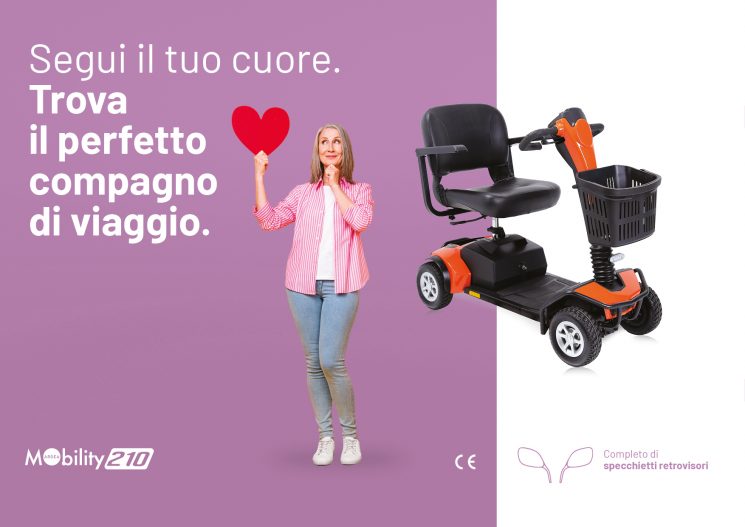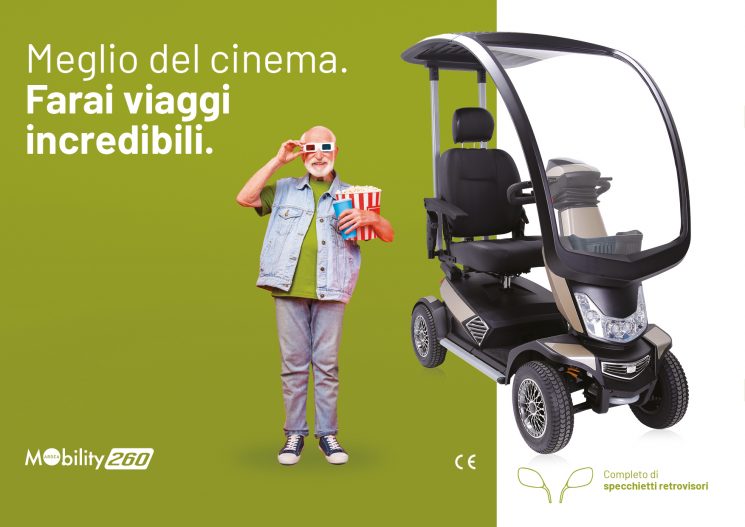It’s not ‘just’ a scooter!
Scooters for the elderly are not all the same. The visual and design aspects are certainly important, but careful consideration should also be given to the functions that make a difference and correspond most closely with the different styles of use
 1. Large or small?
1. Large or small?
It might seem like a trivial aspect, but it is essential carefully to consider the overall dimensions of the scooter we intend to purchase. Dimensions are an important feature that need to be considered in terms of when the scooter will be used, where it will be parked and the possibility of loading it into another means of transport.
Will the scooter be used to move easily around a shopping centre? Will the user need to travel through narrow spaces with the scooter? Does it need a low steering radius when being manoeuvred?
Our Ardea Mobility 200 and 210 scooters are not only easy to handle, thanks to their limited dimensions, but can also be effortlessly disassembled, in order to reduce their dimensions to a minimum for transport.
So, what are the specific functions of a “large” scooter?
The overall dimensions of “large” scooters usually depend, first and foremost, on the width of their wheel diameter. Large wheels guarantee agile and easy use and are therefore preferable for travelling over rough terrain, around small obstacles or on slopes.
Our Ardea Mobility 250 and 260 scooters have 35×10 tyred wheels and an ample, comfy and full optional driving position.
For example, both models have a dashboard with a large LCD display and a comfy and ample driving seat, which rotates, tips up and can be adjusted in height and depth.
2. Features and length of the route
After assessing our needs in terms of dimensions, we should think about the length and features of the route on which the scooter will be used. If the scooter needs to travel easily on slopes, dirt roads or uneven terrain, or for long distances, the best choice is a scooter with large wheels, a powerful motor, high battery autonomy and front and rear suspension.
It is important to remember here that battery autonomy greatly depends both on how the scooter is used (consumption is higher on slopes for example) and also on the weight of the user and the type of terrain.
When purchasing a scooter, it is therefore important to assess the charging time and method carefully, and also correct battery management and maintenance.
3. Physical characteristics of the driver
Scooters for the elderly and people with impaired mobility are stable and safe aids and are simple and immediate to use.
However, it is still a good idea carefully to consider the physical and mental characteristics of the driver in every step of the choice process. As for every mobility aid, the introduction of a scooter should be viewed within a general perspective of regaining independence and freedom, and not simply as a means of regaining the ability to perform a specific activity.
Once this preliminary assessment is complete, it is important to consider the physical characteristics of the driver, opting for scooters that allow the driving position to be “tailored” to their needs, such as adjustment of the depth and height of the seat and the headrest, inclination and width of the armrests and inclination of the handlebar.
4. Safety
 Scooters for the elderly and people with impaired mobility are stable and safe aids. However, when choosing one, it is worth checking whether accessory features are present that guarantee higher safety standards in every situation and in all types of weather.
Scooters for the elderly and people with impaired mobility are stable and safe aids. However, when choosing one, it is worth checking whether accessory features are present that guarantee higher safety standards in every situation and in all types of weather.
The Ardea Mobility scooters have rear-view mirrors, front and rear light kits and direction indicators.
Ardea Mobility 260 also has a wind shield roof, ensuring the utmost comfort in any weather.
5. Practical needs
Considering the physical characteristics of the driver and the everyday mobility needs the scooter must satisfy will provide you with valuable and specific information on which to base your choice of purchase.
However, a further aspect to consider is all the accessory or optional features that allow the scooter to be used in a practical and comfortable way.
The accessories for the Ardea Mobility scooters include front or rear cases, a holder for a canister, walker or crutches, and a detachable roof.
6. Price and tax deduction
Last but not least is the price!
In assessing this purchase option, it is worth considering that Ardea Mobility scooters are medical devices that are tax-deductible for 19% of the purchase value.
They can be supplied by the National Healthcare System, according to the principles established by Ministerial Decree (DM) 332/99 or by the Prime Minister’s Decree (DPCM) of 12.01.2017 (in the regions that have also adopted the measure in the part referring to the National Healthcare Range of Fees).
For more information:










